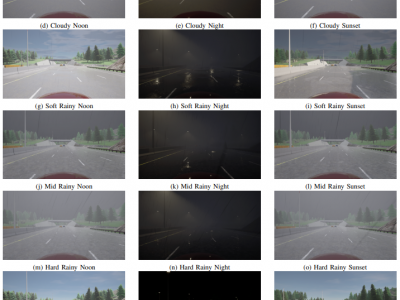Machine Learning
Safety of the Intended Functionality (SOTIF) addresses sensor performance limitations and deep learning-based object detection insufficiencies to ensure the intended functionality of Automated Driving Systems (ADS). This paper presents a methodology examining the adaptability and performance evaluation of the 3D object detection methods on a LiDAR point cloud dataset generated by simulating a SOTIF-related Use Case.
- Categories:
 57 Views
57 ViewsThis is a test dataset for comparison with the latest multi-objective evolutionary algorithms. We have split the experiment into two groups in high and low dimensions respectively, and the experimental results are outstanding. We used IGD as the performance metric, and the data in parentheses are the std of 20 independent repetitions of the experiment and were analyzed for significance.
- Categories:
 67 Views
67 Views
This dataset accompanies a research paper on leveraging Machine Learning (ML) techniques for regression to predict the optimum DC bias in direct current in optical orthogonal frequency division multiplexing (DCO-OFDM). The dataset comprises a set of features to facilitate the prediction of the required DC bias to mitigate the impact of clipping distortion at the transmitter. MATLAB software was utilized for modelling the DCO-OFDM transmission and generating the research dataset.
- Categories:
 68 Views
68 Views
The Comprehensive Hindi Hostile Post Detection Dataset (CM-HTHPD) is collection of Twitter posts written in the Hindi language, focusing on various forms of hostile content. The dataset was gathered using the Twitter Developer API and subsequently annotated manually with sentiment labels using the Label Studio platform. The dataset is primarily aimed at facilitating research and analysis in the domain of hostile content detection and sentiment analysis in Hindi-language social media discourse. The size of the dataset is approx 8300.
- Categories:
 65 Views
65 Views
16.00
Normal
0
false
false
false
EN-GB
X-NONE
X-NONE
- Categories:
 280 Views
280 Views
This dataset is data support for a research paper named “Natural Gas Triethylene Glycol Dehydration Equipment Digital Twin and Condition Evaluation Application”. The paper has been submitted to IEEE Transactions on Industrial Informatics.
- Categories:
 90 Views
90 ViewsIn the data set acquisition phase, the system will automatically record the following data: frontal video recording: the frame rate of the video is 10Hz per second, and the video contains the patient's movement, posture and facial information; hemodynamic data: the acquisition frequency is 10Hz per second, covering the area of the prefrontal lobe of the brain, and including the hemodynamic information of 22 channels; kinematic data: the acquisition frequency is 10Hz per second, and including the hand velocity, shoulder angular velocity, elbow angular velocity and sitting posture information
- Categories:
 388 Views
388 ViewsAs the field of human-computer interaction continues to evolve, there is a growing need for new methods of gesture recognition that can be used in a variety of applications, from gaming and entertainment to healthcare and robotics. While traditional methods of gesture recognition rely on cameras or other optical sensors, these systems can be limited by factors such as lighting conditions and occlusions.
- Categories:
 1031 Views
1031 Views
This dataset is NOx concentration data used for training and testing support vector regression algorithms. There are two groups in total, one for offline algorithm and the other for online algorithm. This data comes from the measured data of a certain ultra supercritical coal-fired boiler under variable operating conditions. The offline model data sampling interval is 5 minutes, and the online model data sampling interval is 5 minutes.
- Categories:
 4 Views
4 ViewsThe dataset comprises image files of size 640 x 480 pixels for various grit sizes of Abrasive sheets. The data collected is raw. It can be used for analysis, which requires images for surface roughness. The dataset consists of a total of 8 different classes of surface coarseness. There are seven classes viz. P80, P120, P150, P220, P320, P400, P600 as per FEPA (Federation of European Producers of Abrasives) numbering system and one class viz. 60 as per ANSI (American National Standards Institute) standards numbering system for abrasive sheets.
- Categories:
 299 Views
299 Views



